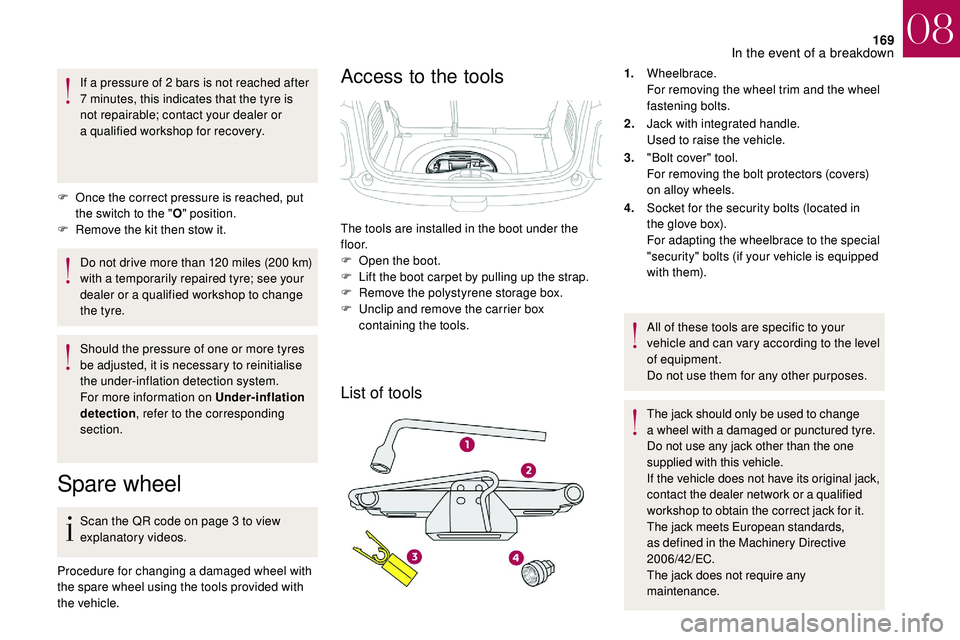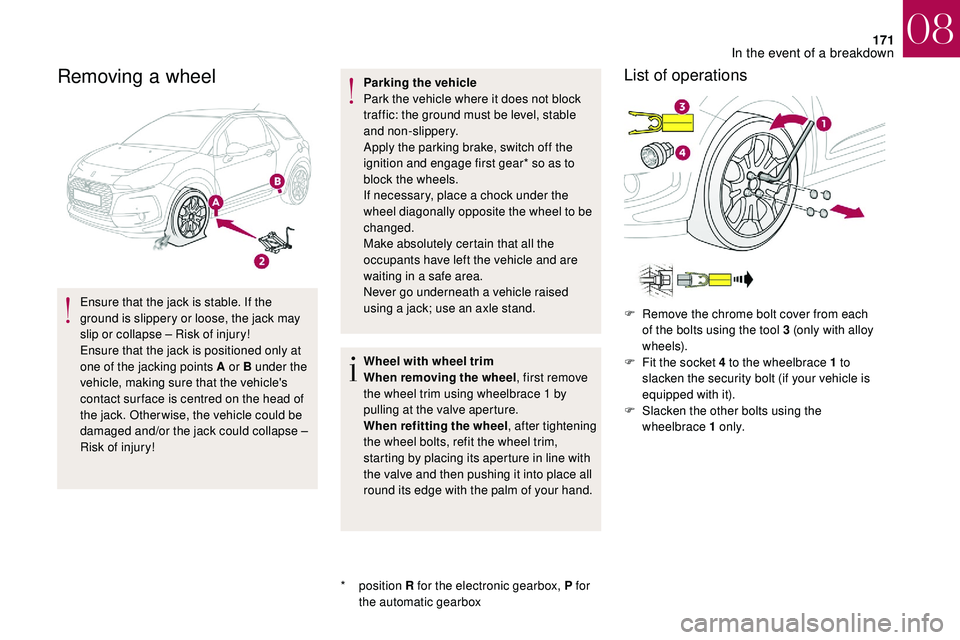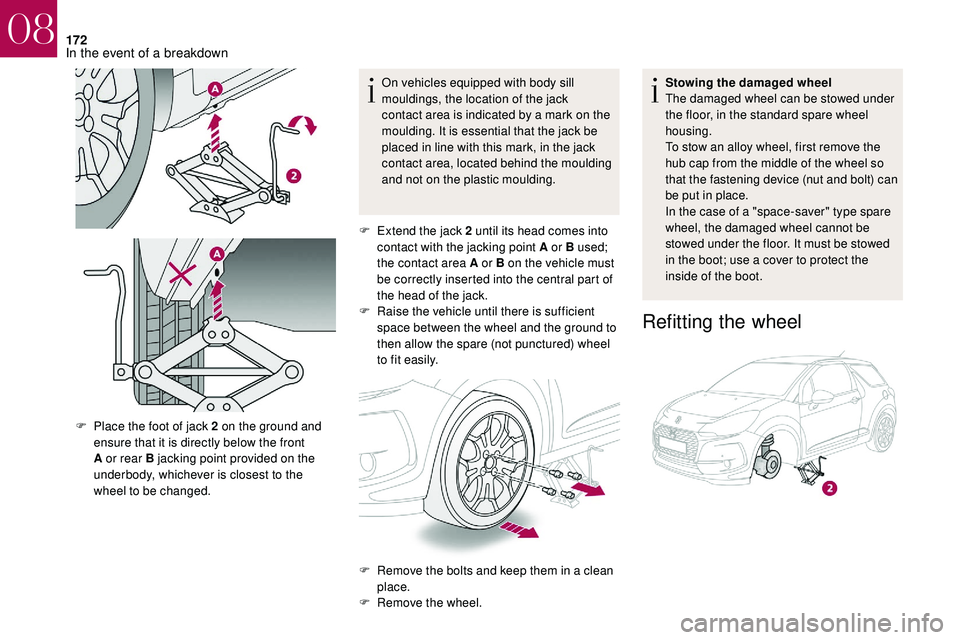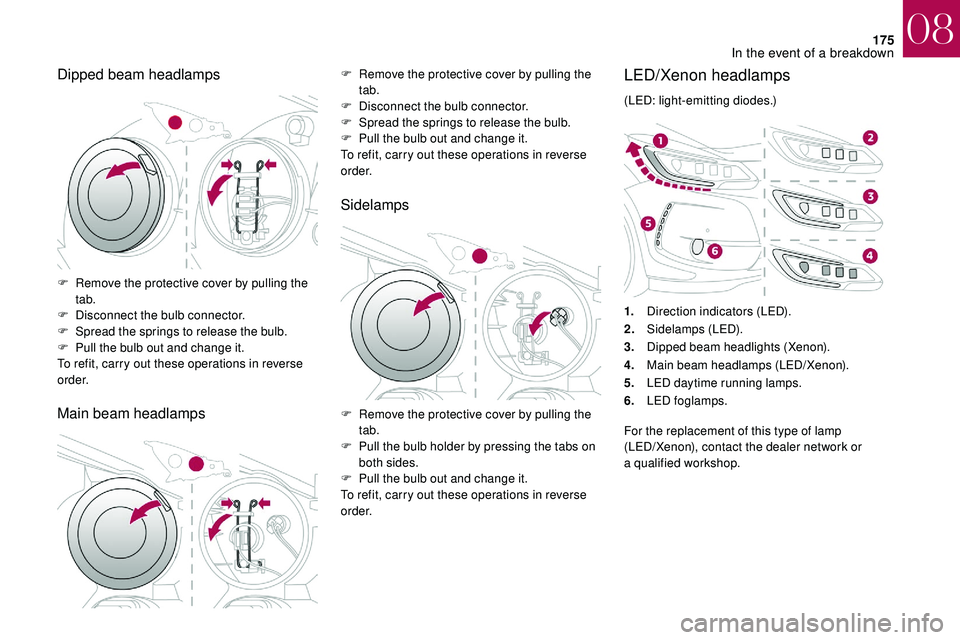CITROEN DS3 2018 Handbook (in English)
Manufacturer: CITROEN, Model Year: 2018, Model line: DS3, Model: CITROEN DS3 2018Pages: 248, PDF Size: 8.79 MB
Page 171 of 248

169
If a pressure of 2 bars is not reached after
7 minutes, this indicates that the tyre is
not repairable; contact your dealer or
a
qualified workshop for recovery.
F
O
nce the correct pressure is reached, put
the switch to the " O" position.
F
R
emove the kit then stow it.
Do not drive more than 120
miles (200 km)
with a
temporarily repaired tyre; see your
dealer or a
qualified workshop to change
the tyre.
Should the pressure of one or more tyres
be adjusted, it is necessary to reinitialise
the under-inflation detection system.
For more information on Under-inflation
detection , refer to the corresponding
section.
Spare wheel
Scan the QR code on page 3 to view
e xplanatory videos.
Procedure for changing a
damaged wheel with
the spare wheel using the tools provided with
the vehicle.
Access to the tools
List of tools
1. Wheelbrace.
For removing the wheel trim and the wheel
fastening bolts.
2. Jack with integrated handle.
Used to raise the vehicle.
3. "Bolt cover" tool.
For removing the bolt protectors (covers)
on alloy wheels.
4. Socket for the security bolts (located in
the glove box).
For adapting the wheelbrace to the special
"security" bolts (if your vehicle is equipped
with them).
All of these tools are specific to your
vehicle and can vary according to the level
of equipment.
Do not use them for any other purposes.
The jack should only be used to change
a
wheel with a damaged or punctured tyre.
Do not use any jack other than the one
supplied with this vehicle.
If the vehicle does not have its original jack,
contact the dealer network or a
qualified
workshop to obtain the correct jack for it.
The jack meets European standards,
as defined in the Machinery Directive
2006/42/EC.
The jack does not require any
maintenance.
The tools are installed in the boot under the
f l o o r.
F
O
pen the boot.
F
L
ift the boot carpet by pulling up the strap.
F
R
emove the polystyrene storage box.
F
U
nclip and remove the carrier box
containing the tools.
08
In the event of a breakdown
Page 172 of 248

170
Access to the spare wheel
Taking out the wheelPutting the wheel back in place
The spare wheel is located in the boot under
t h e f l o o r.
Depending on the country of sale, you will
have a "space-saver" type spare wheel or
a
temporary puncture repair kit.
F
U
nscrew the central nut.
F
R
emove the fastening device (nut and bolt). F
R
aise the spare wheel towards you from the
r e a r.
F
T
ake the wheel out of the boot.
On vehicles with a "space-saver" type
spare wheel, the punctured tyre can
replace the "space-saver" wheel; however,
the boot floor will no longer be even.
F
P
ut the wheel back in its housing.
F
S
lacken the nut on the bolt by a few turns.
F
P
osition the fastening device (nut and bolt)
in the middle of the wheel.
F
T
ighten fully until the central nut clicks, to
retain the wheel correctly. F
P
ut the carrier box back in place in the
centre of the wheel and clip it.
F
P
ut the polystyrene storage box back in
place.
F
R
eposition the carpet at the back of the boot
by folding it gently in two.
08
In the event of a breakdown
Page 173 of 248

171
Removing a wheel
Ensure that the jack is stable. If the
ground is slippery or loose, the jack may
slip or collapse – Risk of injury!
Ensure that the jack is positioned only at
one of the jacking points A or B under the
vehicle, making sure that the vehicle's
contact sur face is centred on the head of
the jack. Otherwise, the vehicle could be
damaged and/or the jack could collapse –
Risk of injury!
*
position R for the electronic gearbox, P for
the automatic gearbox Parking the vehicle
Park the vehicle where it does not block
traffic: the ground must be level, stable
and non-slippery.
Apply the parking brake, switch off the
ignition and engage first gear* so as to
block the wheels.
If necessary, place a
chock under the
wheel diagonally opposite the wheel to be
changed.
Make absolutely certain that all the
occupants have left the vehicle and are
waiting in a safe area.
Never go underneath a vehicle raised
using a jack; use an axle stand.
Wheel with wheel trim
When removing the wheel , first remove
the wheel trim using wheelbrace 1
by
pulling at the valve aperture.
When refitting the wheel , after tightening
the wheel bolts, refit the wheel trim,
starting by placing its aperture in line with
the valve and then pushing it into place all
round its edge with the palm of your hand.
List of operations
F Remove the chrome bolt cover from each of the bolts using the tool 3 (only with alloy
w h e e l s).
F
F
it the socket 4 to the wheelbrace 1 to
slacken the security bolt (if your vehicle is
equipped with it).
F
S
lacken the other bolts using the
wheelbrace 1
o n l y.
08
In the event of a breakdown
Page 174 of 248

172
On vehicles equipped with body sill
mouldings, the location of the jack
contact area is indicated by a mark on the
moulding. It is essential that the jack be
placed in line with this mark, in the jack
contact area, located behind the moulding
and not on the plastic moulding.
F
E
xtend the jack 2 until its head comes into
contact with the jacking point A or B used;
the contact area A or B on the vehicle must
be correctly inserted into the central part of
the head of the jack.
F
Ra
ise the vehicle until there is sufficient
space between the wheel and the ground to
then allow the spare (not punctured) wheel
to fit easily. Stowing the damaged wheel
The damaged wheel can be stowed under
the floor, in the standard spare wheel
housing.
To stow an alloy wheel, first remove the
hub cap from the middle of the wheel so
that the fastening device (nut and bolt) can
be put in place.
In the case of a "space-saver" type spare
wheel, the damaged wheel cannot be
stowed under the floor. It must be stowed
in the boot; use a
cover to protect the
inside of the boot.
Refitting the wheel
F Place the foot of jack 2 on the ground and
ensure that it is directly below the front
A or rear B jacking point provided on the
underbody, whichever is closest to the
wheel to be changed.
F
R
emove the bolts and keep them in a clean
place.
F
R
emove the wheel.
08
In the event of a breakdown
Page 175 of 248

173
Fitting the "space-saver " spare wheel
If your vehicle is fitted with alloy wheels,
when tightening the bolts on fitting, it is
normal to notice that the washers do not
come into contact with the "space-saver"
spare wheel. The wheel is secured by the
conical contact of each bolt.
After changing a
wheel
Do not exceed 50
mph (80 km/h) when
driving with the "space-saver" type spare
wheel fitted.
Visit the dealer network or a
qualified
workshop as soon as possible to have the
tightness of the bolts and the pressure of
the spare wheel checked.
Have the punctured wheel checked. After
inspection, the technician will let you know
if the tyre can be repaired or if it must be
replaced.List of operations
F Put the wheel in place on the hub.
F S crew in the bolts by hand to the stop.
F
P
re-tighten the security bolt (if your vehicle
is so equipped) using the wheelbrace
1
fitted with the security socket 4 .
F
P
re-tighten the other bolts using the
wheelbrace 1
o n l y.
F
N
ow lower the vehicle fully.
F
F
old the jack 2 and detach it. F
T
ighten fully the security bolt (if your vehicle
is so equipped) using the wheelbrace
1 fitted with the security socket 4
.
F T ighten the other bolts using the
wheelbrace 1 o n l y.
F
P
ut the chrome bolt covers back on each of
the bolts (only with alloy wheels).
F
S
tore the tools in the box.
08
In the event of a breakdown
Page 176 of 248

174
Changing a bulb
The headlamps have polycarbonate
lenses with a
protective coating:
F
d
o not clean them using a dr y or
abrasive cloth, nor with a
detergent
or solvent product,
F
u
se a sponge and soapy water or a pH
neutral product,
F
w
hen using a high pressure washer
on persistent marks, do not keep the
lance directed towards the lamps or
their edges for too long, so as not to
damage their protective coating and
seals.
Changing a
bulb must only be done with
the ignition off and after the headlamp has
been switched off for several minutes –
Risk of serious burns!
F
D
o not touch the bulb directly with your
fingers, use a
lint-free cloth.
It is essential only to use anti-ultraviolet
(UV) type bulbs, so as not to damage the
headlamp.
Always replace a
failed bulb with a new
bulb with the same type and specification.
Front lamps
Halogen headlamps
1. Direction indicators (PY21W amber).
2. Sidelamps (W5W).
3. Main beam headlamps (H1-55W).
4. Dipped beam headlamps (H7-55W).
5. LED foglamps.
6. LED daytime running lamps.
Direction indicators
Rapid flashing of the direction indicator
lamp (left or right) indicates that one of
the bulbs on the corresponding side has
failed.
F
T
urn the bulb holder a quarter turn and
remove it.
F
P
ull the bulb out and change it.
To refit, carry out these operations in reverse
o r d e r.
Amber colour bulbs, such as the direction
indicators, must be replaced by bulbs with
identical colour and specifications.
To refit, close the protective cover very
carefully to guarantee the leak-tightness
of the lamp.
08
In the event of a breakdown
Page 177 of 248

175
Dipped beam headlamps
Main beam headlampsF Remove the protective cover by pulling the tab.
F
D
isconnect the bulb connector.
F
S
pread the springs to release the bulb.
F
P
ull the bulb out and change it.
To refit, carry out these operations in reverse
o r d e r.
Sidelamps
F Remove the protective cover by pulling the tab.
F
D
isconnect the bulb connector.
F
S
pread the springs to release the bulb.
F
P
ull the bulb out and change it.
To refit, carry out these operations in reverse
o r d e r.
F
R
emove the protective cover by pulling the
tab.
F
P
ull the bulb holder by pressing the tabs on
both sides.
F
P
ull the bulb out and change it.
To refit, carry out these operations in reverse
o r d e r.
LED/Xenon headlamps
(LED: light-emitting diodes.)
1. Direction indicators (LED).
2. Sidelamps (LED).
3. Dipped beam headlights (Xenon).
4. Main beam headlamps (LED/Xenon).
5. LED daytime running lamps.
6. LED foglamps.
For the replacement of this type of lamp
(LED/Xenon), contact the dealer network or
a
qualified workshop.
08
In the event of a breakdown
Page 178 of 248

176
Integrated direction indicator side
repeaters
Contact the dealer network or a qualified
w orkshop to obtain the module.
LED foglamps
LED daytime running lampsRear lamps
Model with conventional bulb lamps
1. Brake/sidelamps (P21/5W).
2. Sidelamps (P5W).
3. Direction indicators (PY21W amber).
4. Foglamp (PR21W red) or reversing lamp
(P21W ).
Model with rear 3D lamps
F Insert a screwdriver towards the centre of
the repeater between the repeater and the
base of the mirror.
F
L
ever with the screwdriver to extract the
repeater and pull it out.
F
D
isconnect the connector from the repeater.
F
R
eplace the module.
To refit, carry out these operations in reverse
o r d e r. For the replacement of this type of diode
lamp, contact the dealer network or a
qualified
workshop.
For the replacement of this type of diode
lamp, contact the dealer network or a
qualified
workshop. 1.
3D LED sidelamps.
2. LED brake/sidelamps.
08
In the event of a breakdown
Page 179 of 248

177
3.LED side marker lamps.
4. Direction indicators (PY21W amber).
5. Foglamp (H21W red) or reversing lamp
(H21W ).
Amber or red colour bulbs, such as the
direction indicators or foglamps, must be
replaced by bulbs with identical colour and
specifications.
Access to bulbs
Removing the access cover
F Open the boot.
Ty p e 1 Ty p e 2Removing the lamp
To reassemble, proceed in reverse order.
Make sure to engage the lamp unit in its guides
while keeping it in line with the vehicle.
Refitting the access cover
Ty p e 1
F
R
emove the access cover by pulling it
downwards.
F
U
nscrew the lamp fixing wing nut.
F
U
nclip the lamp unit connector.
F
E
xtract the lamp unit carefully pulling it
straight towards the outside. F
P
osition the 3 hooks A of the cover in the
lower part.
08
In the event of a breakdown
Page 180 of 248

178
Ty p e 2
Changing bulbs
Model with conventional bulb lampsModel with rear 3D lamps
Direction indicators (4) and foglamp or
reversing lamp (5)
Replacing LED sidelamps and brake
lamps (diodes)
For the replacement of this type of diode
lamp, contact the dealer network or a
qualified
workshop.
F
T
ip the cover upwards and position the
hooks B under the boot trim.
F
Ra
ise the cover.
F
S
lide the cover so as to put it properly back
in place. F
P
osition the cover in the lower part.
F
T
ip the cover upwards.
F
T
urn the bulb a quarter of a turn and change
it.
F
S
pread the four tabs and remove the bulb
h o l d e r.
F
T
urn the bulb a
quarter turn and change it.
08
In the event of a breakdown